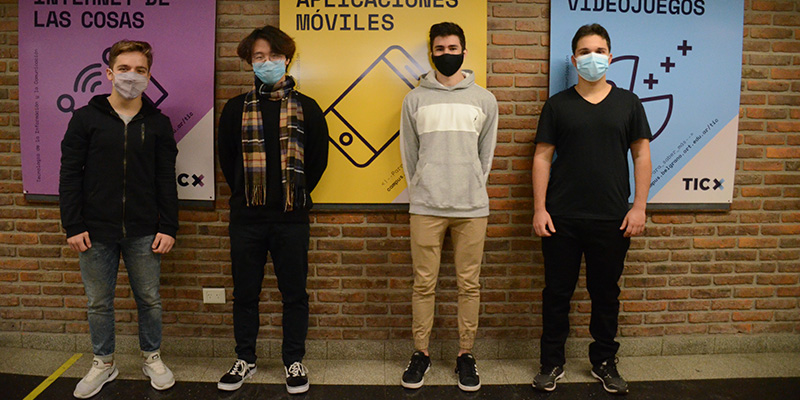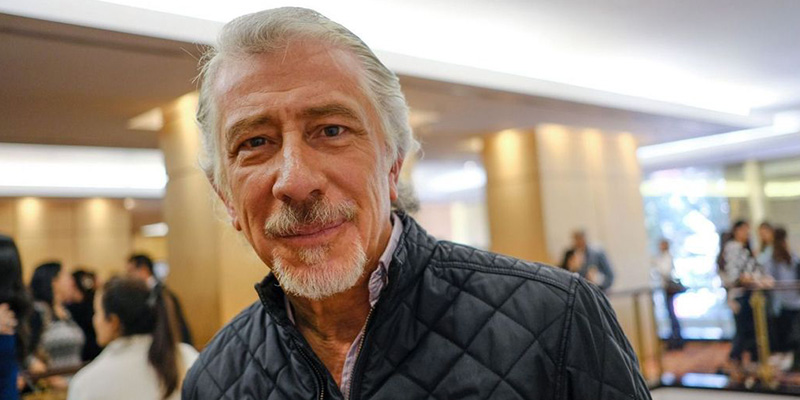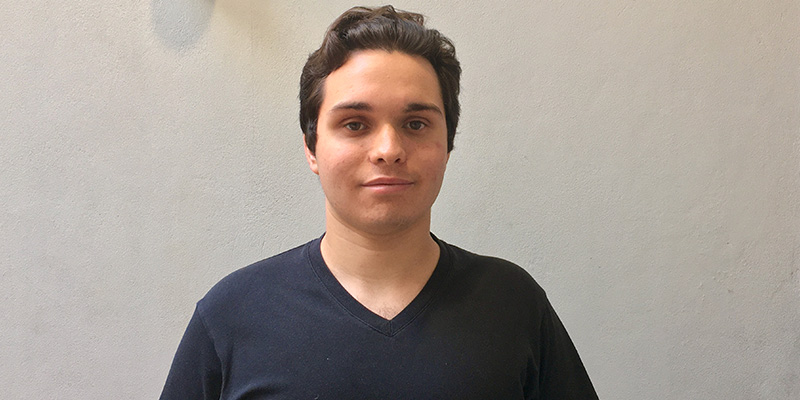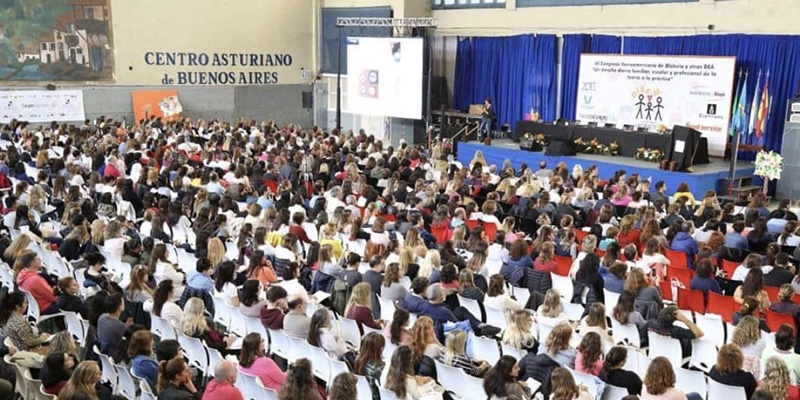“The fact that 10% of the world population has dyslexia is a very high and worrying number when little help is available,” says Ulises López Pacholczak, who together with Fausto Fang, Lisandro Elías Acuña and Gonzalo Díaz de Vivar created ―when they were 16 years old and they were in high school together― an application that facilitates reading and writing for people with this difficulty, through tools such as colors, pictograms and audio. Developed with the support of Disfam, the largest non-profit organization for people with dyslexia in Ibero-America, LectO is downloaded in 35 countries and by almost 25,000 users in seven languages.
Last October 8 was International Dyslexia Day. This specific learning difficulty that affects literacy is indeed the reality of 1 out of 10 people in Argentina. It has a persistent character, is of neurobiological origin and is usually hereditary. And yet, the vast majority of people with dyslexia are undiagnosed.

Gustavo Abichacra, pediatrician, master's degree in child and adolescent psychiatry and president of the Scientific Committee of Disfam Argentina, explains that dyslexia "manifests itself in the difficulty in learning to read after an explicit teaching of reading in healthy children with cognitive abilities. enough, but that it is difficult for them to access reading like the rest of their classmates”. They can't do it smoothly, accurately, or automatically. Without a diagnosis and treatment, it brings academic consequences, but especially emotional and self-esteem.
Having tools like a text editor that alleviate some of these challenges is always welcome and necessary everywhere.
“Having dyslexia is like reading Portuguese without knowing Portuguese and writing with your left hand, being right-handed,” explains Abichacra. That is why content access tools are as essential as providing glasses to a visually impaired person. "For children with dyslexia it is not to give them an advantage, but the possibility of understanding the texts and expressing themselves in an appropriate way," he says.
In this, it coincides exactly with Ulises' vision: “LectO offers different tools that help improve reading and writing skills. At the time we thought of it as glasses for people with dyslexia. The same ones that help someone improve her vision when she really needs them. LectO is like your glasses; it allows access to the texts and facilitates writing”. Ulises studies Computer Science at the University of Buenos Aires. “I am in the first year of the Common Basic Cycle and I started with LectO in 2019. There I was more in charge of programming, especially for the Windows application and also of backend, the part of the app< /em> that the user does not see”, he says. Currently, as his colleagues, he deals with the specific requirements of the application.
Ulysses, Fausto, Lisandro and Gonzalo are 19 years old today and are in college. They created this application three years ago, in the specialization of Information and Communication Technology at their school: the Belgrano ORT in Buenos Aires.

Then each began their university career. Two of the team members won scholarships to study in the United States, one at Stanford and the other at New York University. The other two decided to stay in Argentina.
A student project
“In high school I already loved programming just like my LectO classmates. The specialization we chose is a mix between software, hardware and other technology stuff. In the third year we got together for the final project and we thought if we could do something that would really help society. We were looking for a fruitful and motivating theme, that the time we dedicated to it would improve someone's life. So, we focused on the dyslexia of some of our peers. We had meetings, consultations, we researched and developed the first version of LectO”, says Ulises. Initially, they presented the tool as a text editor very similar to Word, but later they added some accessibility resources to improve the reading of people with dyslexia. The first version, which they released in December 2019, had many errors, but it also opened many doors for them, such as advice from Disfam. That gave them the impetus to – in the midst of a pandemic – develop the first desktop version. Users could download it to their computer through the Windows Store.
“It had quite a few users, but we realized there were a lot of people who needed to use the app on tablets or cell phones and that Windows platform didn't allow it. So, by the end of 2020, beginning of 21, we achieved the first web version that can be accessed from any device”, says Ulises.
Make tasks easier
LectO does not represent a solution to dyslexia, which needs a comprehensive and ideally early approach, but it helps children and adults in reading and writing. It does this through its different functionalities, such as listening to the text or “standing” on a word and bringing up its image in a pictogram. Also take photos of any printed text, upload the images to the application and be able to read and listen to that text. Or edit, mark words or letters with certain colors to read more easily. All this, with the option to choose from the seven most dyslexia-friendly fonts, change their size and adjust the speed of the voice.
Users report things to improve, which will surely be addressed by the developers in future updates: difficulties for the application to "take" correctly the letters with accents characteristic of Spanish or errors in the texts downloaded from photos, as Carolina says Bonetti, mother of 8-year-old Agustín. But they continue to use it because even having to correct these issues -which today are still repeated to a greater or lesser extent in almost all readers and text editors- it helps them in their daily tasks.
“It is important to correct the functions of these tools, so that they are more precise and remain flexible and simple. They are crucial in facilitating autonomy, which is what one looks for in a child with dyslexia. That they, in this search for the tools they need to be able to study, find autonomy. In my son's case, it's not that I don't want to read the text to him, but rather that he knows that if he needs to access a text, he doesn't need his mother to read it to him, but that he has the tools to do it the way he does today. can, which is through an application”, says Carolina.
“At the time, one of the biggest challenges was making the application really solve a problem, because it is very different from solving something abstract in mathematics, for example. I love mathematical computation and this year I competed in the International Computer Olympics representing Argentina: there they give you very abstract problems, which are not so real; they stimulate you to propose an algorithm to solve a logical mathematical problem. But when you want to tackle a problem for one person, for a group of people, you can't sit back and say, 'I'm making this up and I hope everyone uses it, just because I think my code and solution are great.' The great challenge was to validate and work side by side with the potential users of our application. Disfam not only publicized our work, but also helped us recruit people for the initial testing of the application to see if it was usable and intuitive so that more people could access this free solution and we could help improve more experiences”, explains Ulises.< /p>
Although the tool uses free websites, the project is supported by donations that can be made through a button on the page and allow us to improve the infrastructure of the servers and the operation of the application without having to charge anything for their use.

Understanding the problem
As Disfam Spain explains on its website, the main problem with dyslexia is that it is not compatible with the educational system in general, because learning occurs through written code. This complicates the child with dyslexia who, even intelligent, it cannot assimilate certain contents in the same way as the rest.
You need to put so much effort into literacy tasks that you tend to get tired, lose focus, become distracted, and reject these types of tasks. Parents and teachers may interpret this behavior as disinterest and push for more effort. But what happens to this child is what an adult who is suddenly in the middle of a Chinese writing class can feel.
“These challenges make them spend three times more time and five times more brain power than their peers,” explains Abichacra. “Any tool that allows them to dictate to a screen, for example, a text that is written automatically, without spelling errors, is an absolute ally. The same thing happens with the reading of texts that are made audible, so that they do not have to put all their attention on the mechanism of reading. That way they can focus on what the author wants to convey to them.”
In dyslexia there are not only difficulties in reading and writing. “There can also be challenges in comprehension, short-term memory, access to language; confusion between right and left or difficulties in spatio-temporal notions. There are no two people with the same dyslexia, that is why each case is unique and does not have to present all the symptoms”, explains Disfam on its website.
When there is doubt about whether a child or an adult has dyslexia, there is the Prodislex screening protocol, with versions for each stage of life. If many symptoms are met, a neurocognitive evaluation with a professional is advisable. Although it can be diagnosed and treated at any age, early detection is essential to prevent emotional consequences, demotivation and school failure. But each person is different; some begin to show difficulties in kindergarten or elementary school, others in high school and even in college or work.
“The most important reflection on dyslexia for me always points to the possible consequences on the emotional development of children. They are learning to be people who have to feel empowered to achieve what they want, since their cognitive abilities sometimes even exceed those of the average population. But the psychological consequences of dyslexia not addressed correctly can lead them to feel anxiety about the daily tasks that are presented to them. An anxiety different from the one we can all have in the face of challenges or something new. The difficulties of dyslexia can complicate their functionality in the actions of daily life, due to anxiety, frustration or fatigue. They may lower their arms or enter into what is called 'learned helplessness' because whatever they do, despite the effort, the results are the same. That is why early diagnosis and monitoring by the entire society is so important,” Abichacra points out.
Spelling checkers, text readers or any type of support are resources that help people with dyslexia unfold their potential, which is great.
“Regardless of the access tools and the way they can give you at school, such as advancing a text, enlarging the font, a little more time, favoring orality or taking shorter tests, all the support tools do that both reading and writing texts be made easier, which is where the difficulty lies,” Abichacra stresses.
In fact, in the event of a diagnosis of dyslexia, it is advisable to work with a specialist in learning reeducation and, if necessary, in the emotional aspect. Explain to the child or adolescent what is happening and normalize the picture by pointing out the positive characteristics of people with dyslexia, who are usually great visual thinkers, very creative, intelligent and sensitive, among other qualities. At school, adaptations must be made so that they comply with the same contents and objectives as the rest of their classmates, but with certain modifications in access. Avoid conflicts in the classroom, embrace diversity and prevent bullying. For this, the computer or tablet, specific software programs, reader, corrector, calculator, multiplication tables, voice recorder and visual schedules, and applications such as LectO can help.
In 2016, the National Law 27306 on the comprehensive and interdisciplinary approach to subjects with specific learning difficulties “radically changed” the panorama of how dyslexia is approached in schools. Abichacra says: "Although we are still far from ideal, many teachers have been trained, have been interested in the subject, which for most was unknown."
Argentina is one of the few territories in the Americas where there is a specific national law that, among other things, establishes mandatory teacher training. In addition, it provides tools for both students and their parents to request that adaptations be made to access and teaching, "even if there is a refusal by some institution," adds the specialist.

To talk about all these issues, and access training and updates, on October 21, 22 and 23, the 5th Congress on Dyslexia and other DEAs will be held in CABA with virtual modality as well, under the motto "Appreciating the effort contemplating the emotions.”
As María Arabetti, president of Disfam Argentina, explains, the meeting is open to people with or without dyslexia, professionals, families, teachers, managers, doctors and more. The registration link is: https://www.disfam.org/argentina /congreso/ and for more information you can write to contacto@disfam.com.ar.
The LectO team, in addition to providing a tool, is interested in transmitting a motivating message to young people who are in high school or are starting their career. This is how Ulises explains it: “I like to say that programming, learning to use the computer, information technology, opens many doors for you. Today society is immersed in a digital environment and through programming one can do many things and change the lives of many people. Programming not only allows you to create products, but also changes the way you think from mathematics and logic. If you feel like it, from a very young age you can improve the environment. Do things a little better, think more about the other”.
This note is part of the platform Solutions for Latin America, an alliance between INFOBAE and RED/ACCION, and was originally published Oct 17, 2022.
You can read this content thanks to hundreds of readers who support our human journalism with their monthly support 





